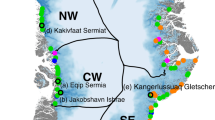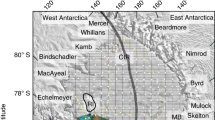Abstract
Large uncertainties remain in the current and future contribution to sea level rise from Antarctica. Climate warming may increase snowfall in the continent’s interior1,2,3, but enhance glacier discharge at the coast where warmer air and ocean temperatures erode the buttressing ice shelves4,5,6,7,8,9,10,11. Here, we use satellite interferometric synthetic-aperture radar observations from 1992 to 2006 covering 85% of Antarctica’s coastline to estimate the total mass flux into the ocean. We compare the mass fluxes from large drainage basin units with interior snow accumulation calculated from a regional atmospheric climate model for 1980 to 2004. In East Antarctica, small glacier losses in Wilkes Land and glacier gains at the mouths of the Filchner and Ross ice shelves combine to a near-zero loss of 4±61 Gt yr−1. In West Antarctica, widespread losses along the Bellingshausen and Amundsen seas increased the ice sheet loss by 59% in 10 years to reach 132±60 Gt yr−1 in 2006. In the Peninsula, losses increased by 140% to reach 60±46 Gt yr−1 in 2006. Losses are concentrated along narrow channels occupied by outlet glaciers and are caused by ongoing and past glacier acceleration. Changes in glacier flow therefore have a significant, if not dominant impact on ice sheet mass balance.
This is a preview of subscription content, access via your institution
Access options
Subscribe to this journal
Receive 12 print issues and online access
$259.00 per year
only $21.58 per issue
Buy this article
- Purchase on Springer Link
- Instant access to full article PDF
Prices may be subject to local taxes which are calculated during checkout


Similar content being viewed by others
References
Davis, C. H., Li, Y., McConnell, J. R., Frey, M. M. & Hanna, E. Snowfall-driven growth in East Antarctic Ice Sheet mitigates recent sea level rise. Science 308, 1898–901 (2005).
Shepherd, A. & Wingham, D. Recent sea-level contributions of the Antarctic and Greenland Ice Sheets. Science 315, 1529–1532 (2007).
Huybrechts, P., Gregory, J., Janssens, I. & Wild, M. Modelling Antarctic and Greenland volume changes during the 20th and 21st centuries forced by GCM time slice integrations. Global Planet. Change 42, 83–105 (2004).
Thomas, R. H., Rignot, E. & Kanagaratnam, P. Force-perturbation analysis of Pine Island Glacier, Antarctica, suggests cause for recent acceleration. Ann. Glaciol. 39, 133–138 (2004).
Scambos, T., Bohlander, J. A., Shuman, C. A. & Skvarca, P. Glacier acceleration and thinning after ice shelf collapse in the Larsen B embayment, Antarctica. Geophys. Res. Lett. 31, L18402 (2004).
Rignot, E. et al. Accelerated ice discharge from the Antarctic Peninsula following the collapse of Larsen B ice shelf. Geophys. Res. Lett. 31, L18401 (2004).
De Angelis, H. & Skvarca, P. Glacier surge after ice shelf collapse. Science 299, 1560–1562 (2003).
Rignot, E. et al. Recent ice loss from the Fleming and other glaciers, Wordie Bay, West Antarctic Peninsula. Geophys. Res. Lett. 32, L07502 (2005).
Pritchard, H. & Vaughan, D. Widespread acceleration of tidewater glaciers on the Antarctic Peninsula. J. Geophys. Res. 112 (2007) (doi:10.1029/2006JF000597).
Thomas, R. H. et al. Accelerated sea-level rise from West Antarctica. Science 306, 255–258 (2004).
Rignot, E. Changes in ice dynamics and mass balance of the Antarctic ice sheet. Phil. Trans. R. Soc. A 364, 1637–1656 (2006).
Rignot, E. & Thomas, R. H. Mass balance of polar ice sheets. Science 297, 1502 (2002).
Haran, T., Bohlander, J., Scambos, T. & Fahnestock, M. MODIS Mosaic of Antarctica (MOA) Image Map (National Snow and Ice Data Center, Boulder, 2005).
Bamber, J. L. & Gomez, J. L. The accuracy of digital elevation models of the Antarctic continent. Earth Planet. Sci. Lett. 237, 516–523 (2005).
Tapley, B. et al. GGM02—An improved Earth gravity field model from GRACE. J. Geodesy (2005) (doi:10.1007/s00190-005-0480-z).
van den Broeke, M. R. Towards quantifying the contribution of the Antarctic ice sheet to global sea level change. J. Phys. IV France 139, 179–187 (2006).
van den Broeke, M., van de Berg, W. & van Meijgaard, E. Snowfall in coastal West Antarctica much greater than previously assumed. Geophys. Res. Lett. 33, L02505 (2006).
van de Berg, W., van den Broeke, M., Reijmer, C. & van Meijgaard, E. Reassessment of the Antarctic surface mass balance using calibrated output of a regional atmospheric climate model. J. Geophys. Res. 111, D11104 (2006).
van den Broeke, M., van de Berg, W. J., van Meijgaard, E. & Reijmer, C. Identification of Antarctic ablation areas using a regional atmospheric climate model. J. Geophys. Res. 111, D18110 (2006).
Giovinetto, M. & Zwally, J. Spatial distribution of net surface accumulation on the Antarctic ice sheet. Ann. Glaciol. 31, 171 (2000).
Arthern, R. J., Winebrenner, D. P. & Vaughan, D. G. Antarctic snow accumulation mapped using polarization of 4.3-cm wavelength microwave emission. J. Geophys. Res. 111, D06107 (2006).
Joughin, I. & Bamber, J. Thickening of the ice stream catchments feeding the Filchner-Ronne ice shelf, Antarctica. Geophys. Res. Lett. 32, L17503 (2005).
Joughin, I. & Tulaczyk, S. Positive mass balance of the Ross Ice Streams, West Antarctica. Science 295, 476–480 (2002).
Jacobs, S. Observations of change in the Southern Ocean. Phil. Trans. R. Soc. A 364, 1657–1681 (2006).
Domack, E. W., Burnett, A. & Leventer, A. Antarctic Research Series Volume 79: Peninsula and Climate Variability 1–14 (American Geophysical Union, Washington DC, 2003).
Gille, S. Warming of the southern ocean since the 1950s. Science 295, 1275–1277 (2002).
Monaghan, A. J. et al. Insignificant change in Antarctic snowfall since the international geophysical year. Science 313, 827–831 (2006).
Acknowledgements
We thank R. Arthern for discussions. This work was carried out at Caltech’s Jet Propulsion Laboratory, the University of California Irvine and the University of Missouri, Columbia, under a contract with NASA’s Cryospheric Science Program. J.L.B. was supported by NERC grant NE/E004032/1. SAR data were provided by the European Space Agency VECTRA project, the Canadian Space Agency, the Japanese Space Agency, and the Alaska Satellite Facility. ERS-2 radar altimeter data were provided by NASA/GSFC.
Author information
Authors and Affiliations
Contributions
All authors discussed the results and commented on the manuscript. E.R. led the remote sensing analysis, development of the paper and integration of the results, J.L.B. provided a digital elevation model and analysed its accuracy, M.R.B., W.J.B. and E.M. contributed calculations of snow accumulation, firn depth correction and associated errors and C.D. and Y.L. analysed elevation changes from satellite radar altimeter data.
Corresponding author
Supplementary information
Supplementary Information
Supplementary information table S1 (PDF 131 kb)
Rights and permissions
About this article
Cite this article
Rignot, E., Bamber, J., van den Broeke, M. et al. Recent Antarctic ice mass loss from radar interferometry and regional climate modelling. Nature Geosci 1, 106–110 (2008). https://doi.org/10.1038/ngeo102
Received:
Accepted:
Published:
Issue Date:
DOI: https://doi.org/10.1038/ngeo102
This article is cited by
-
Heterogeneous melting near the Thwaites Glacier grounding line
Nature (2023)
-
Impacts of sea-level rise on coastal zones of Mauritius: insights following calculation of a coastal vulnerability index
Natural Hazards (2022)
-
Widespread increase in dynamic imbalance in the Getz region of Antarctica from 1994 to 2018
Nature Communications (2021)
-
Automatic delineation of glacier grounding lines in differential interferometric synthetic-aperture radar data using deep learning
Scientific Reports (2021)
-
Tropical teleconnection impacts on Antarctic climate changes
Nature Reviews Earth & Environment (2021)



